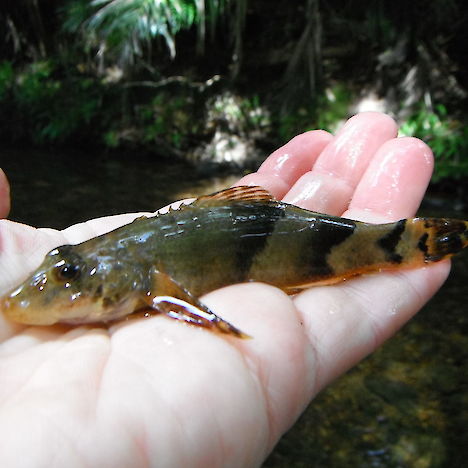Other names:
PapanokoThreat category:
At Risk: Declining?Regions:
Northland, Auckland, Waikato, Bay of Plenty, Gisborne, Hawkes Bay, Manawatu-Wanganui, Taranaki, Wellington, Nelson-Tasman, Marlborough, Westcoast, Canterbury, Otago, SouthlandDistribution:
Widespread.
Description
- A robust fish with a flattened belly and arched back; head is large, broad and flattened.
- Grey to greyish-brown, with four distinctive diagonal stripes across the body sloping forward and downward from back to belly.
Interesting Facts
- Favours gravel/cobble rivers, especially swift tumbling riffles.
- Eats aquatic invertebrates.
- Migrates to spawn; larvae get washed out to sea and juveniles return to freshwater in spring and summer, but details not well known.
- Some indigenous fish species are widespread but in low numbers and declining, e.g. longfin eel, giant kokopu, koaro and inanga.
- River species require good riparian cover, streamside shade and logs and/or boulders instream.
Association with Plantations
- All indigenous fish can occur in, or move through, plantation forestry areas.
- Plantation streams and lakes often have relatively high populations of indigenous fish.
Threats
- Destruction of riparian vegetation.
- Competition and predation from introduced fish species.
- Habitat destruction from:
- Modification of riparian margins.
- Introduction of aquatic weeds.
- Siltation.
- Eutrophication (high nutrients).
- Erosion of banks through grazing by livestock, goats and deer.
- Artificial barriers to upstream migration (e.g. culverts, fords with large lips creating a drop off).
- Depleted flows caused by water abstraction.
Management Options and Methods
- Maintain corridors of riparian vegetation along banks. Corridors should be as extensive as possible (refer to Buxton 1991).
- If possible, expand width of riparian zones during later rotation planting.
- Exclude livestock from riparian areas.
- Control deer and goats that could enter riparian areas.
- Comply with best forest operational management practices to avoid damage to riparian areas.
- Provide adequate fish passage through any artificial barriers within streams, e.g. building up downstream side of culverts with Gabion baskets of boulders or using other designs (refer Buxton 1991, Jowett 1999).
- Manage or prevent water abstraction from critical habitat areas.
- Regulate or prevent fishing of threatened species.
- Prevent introductions of exotic fish.
- Prevent introductions of aquatic weeds. Educate local users of weed threats and how to prevent spread.
Monitoring Options
- Undertake surveys to identify fisheries values and species.
- Consider repeating fish surveys every few years to ascertain whether key species are still present.
- Liaise with DOC about fish survey and monitoring methods.
- Report findings to DOC.
- Periodic checks of banks to ensure compliance with best forest operational management practices, pest and weed levels and siltation.
Further Information and Support
- DOC – advice for management, survey, and monitoring. Website http://www.doc.govt.nz/
- Buxton 1991. New Zealand’s wetlands: a management guide. Wellington, Department of Conservation.
- Jowett I. et al. 1999. Fish passage at culverts: a review with possible solutions for New Zealand indigenous species.
- McDowall R.M. 2000. The Reed Guide to Freshwater Fishes.
- NIWA website, Atlas of New Zealand freshwater fishes. Contains detailed identification guides and location maps. http://www.niwa.cri.nz/rc/freshwater/fishatlas


